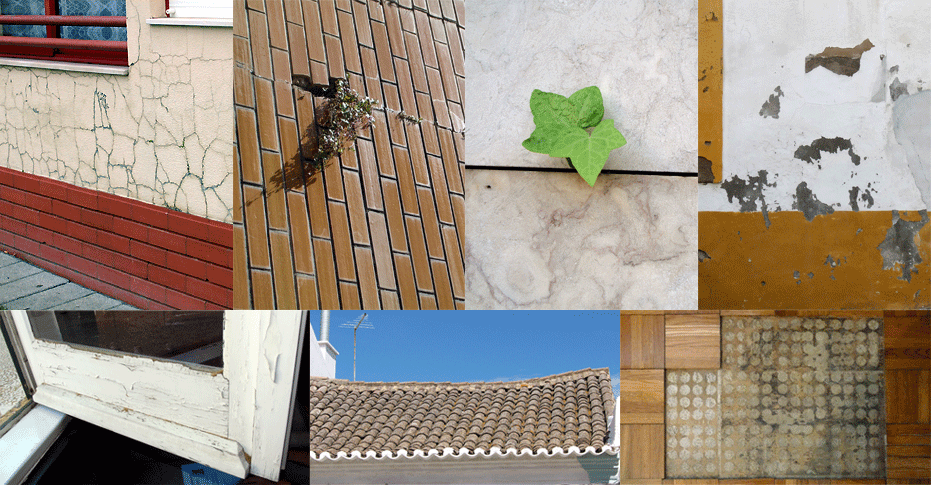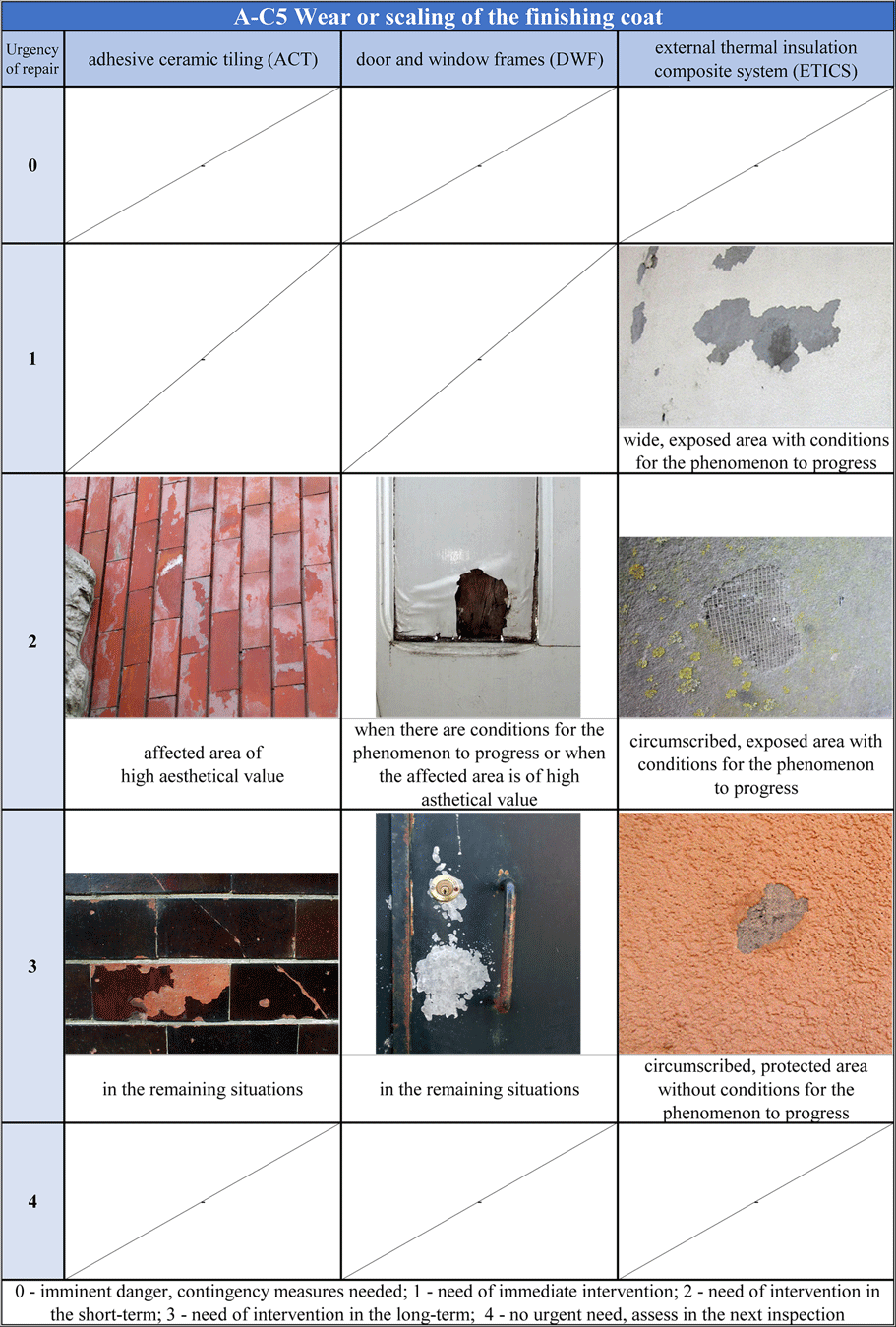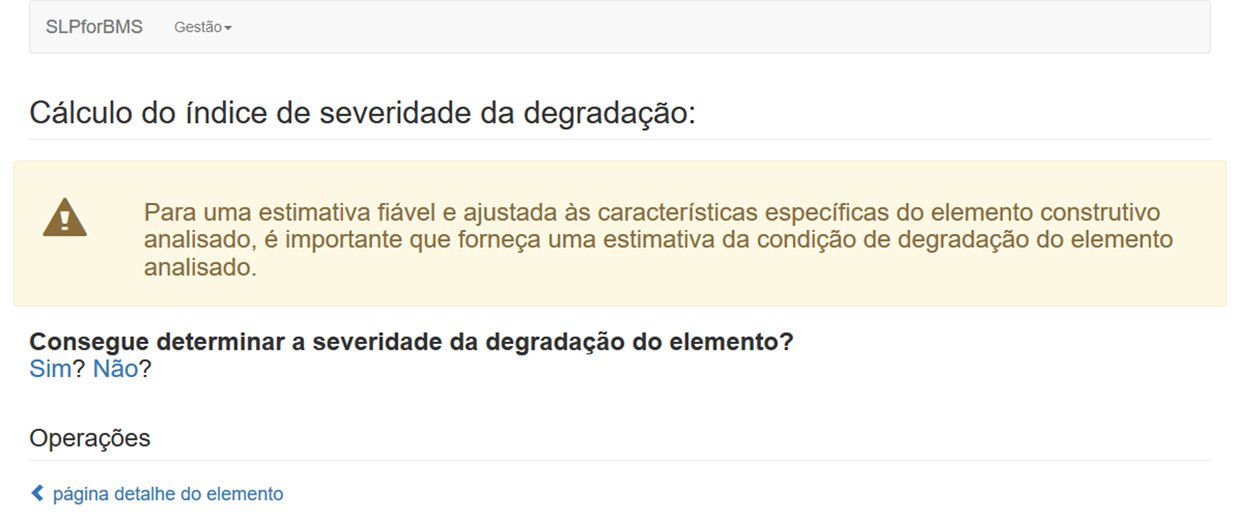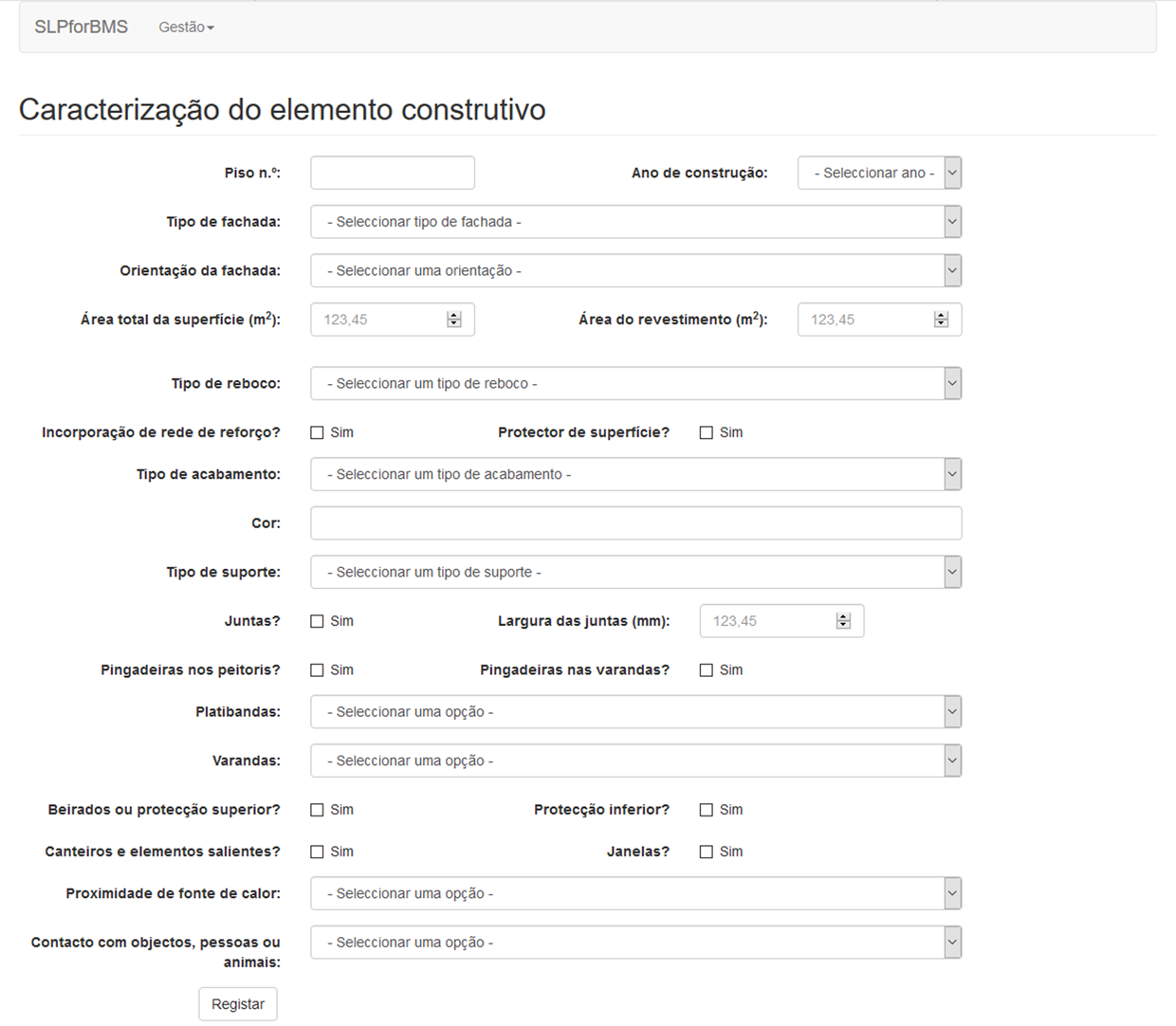Welcome to SLPforBMS
Service Life Prediction for a risk-based Building Management System


Task 1 comprises the analysis of several studies developed at Insituto Superior Técnico (IST), University of Lisbon (UL), within the scope of the building pathology assessment methods. These systems followed the same systematic approach and, for that reason, comprise the following tools: i) Ranking lists of defects, causes, diagnosis methods and repair techniques; ii) Defect - causes correlation matrix; iii) Inter-defects correlation matrix; iv) Defects - diagnosis methods correlation matrix; v) Defect - repair techniques correlation matrix; vi) Defects’ files; vii) Diagnosis methods’ files; viii) Repair techniques’ files; and ix) Inspection form. In order to systematize all these data, this task intended to create an overall system based on normalized lists of defects, causes, diagnosis methods and repair techniques.
In this task, the research team performed the joint examination of the partial systems, matching the systemic pattern and nomenclature. Based on the partial systems, initially developed for the different building components, a new and optimised system was developed, by cross-checking the various systems. The reliability of each partial system was analysed, and additional inspections were performed in order to calibrate the new overall inspection system.
For the creation of the overall system, in the first place, the criteria for the classification of the anomalies were standardised (progress report “Task 1.1”), creating an overall list of defects for the different building components analysed. Initially (and as described in the project proposal), the following elements were analysed: i) Flat roofs (CT); ii) Adhesive ceramic tiling (RCA); iii) Epoxy resin industrial floor coatings (REPI); iv) Wood floorings (RPL); v) Natural stone cladding (RPN); vi) Architectural concrete surfaces (SBV); vii) External claddings of pitched roofs (RECI); viii) Wall renderings (RP); ix) Painted façades (RPFR); x) External thermal insulation composite systems (ETICS); and xi) Door and window frames (C). During the progress of this research project, a new element was included in the system, namely vinyl and linoleum floorings, and the entire system was revised and standardised in order to include this new element (progress report “Task 1.12”). Table 1 shows the standardised system of classification of the defects that can occur in the elements of the envelope analysed in the present project.

The overall inspection system developed in this task presents the following elements:
Task 1 of the project consists of the definition of a “degradation atlas” (progress report “Task 1.10”), which illustrates the various types of defects that affect the building envelope (coatings and roofs). These data are based on written and visual information obtained through expert-knowledge systems. Figure 1 shows an illustrative example of the degradation atlas. Finally, to complete Task 1, the inspection system was validated through the inspection of new elements, which allowed the calibration and validation of the expert system proposed in the project (progress report “Task 1.11”).

Upon the creation of the overall inspection system, as described, an online platform was created in order to compute the information collected by the inspector during the fieldwork surveys. The computational tool intends to minimise the subjectivity of inspections of the building envelope, which has been identified in the literature as one of the biggest challenges in the field of building pathology systems.
Before the definition of the computational tool, the research team considered that a question should be raised: “Do users need a buildings’ inspection, diagnosis and service life prediction software?” (this study has been published in the Journal of Building Engineering). In this sense, a market survey was performed (progress report “Task 2.1”), involving 57 varied stakeholders working on the maintenance sector (in different countries, namely Portugal, Spain, Italy, Nordic countries, United Kingdom and other European countries, Japan, Singapore, New Zealand, Australia, USA, Brazil, among others). The survey allows evaluating the usefulness of the proposed computational tools, identifying the characteristics that the software must have to ensure its use by the sector.
Initially, the research team started to develop the computational tool, visually defining the front-end of the software (progress report “Task 2.2”). The research team defined the interface of the computational tool, as well as all the information that should be included in the software to allow an adequate characterisation of the construction elements analysed.
A progress report (“Task 2.3”) was performed, to systematise all the required information for the development of the software’s back-end, which includes some relevant information for dealing with the inspection forms by defining: i) the different types of completion fields (mandatory or optional); ii) fields that must allow multiple answers; iii) the description of the calculation algorithm to establish the urgency of repair of each anomaly; and iv) the definition of the output for the inspection report.
A beta version of the software was created, in a time-consuming trial and error process, since none of the members of the research team are specialised in computer science. A new progress report was prepared (“Task 2.4”) to evaluate the beta version of the software, in order to identify the opportunities to improve the building inspection software. In this analysis, three kinds of possible improvements are identified: i) correction of incomplete or incorrectly implemented processes; ii) process improvement through the implementation of additional functionalities; and iii) software update in line with the latest changes to the global inspection system.
Finally, the research team decided to use part of the project budget, with the permission of the Fundação para a Ciência e a Tecnologia (FCT), to hire a specialist to improve the original version of the software and also for the development of the service life prediction software. Therefore, the final version of the software was accomplished in Task 5 of the project, with the definition of the two computational tools, which can be used separately or jointly by taking advantage of the data collected during the inspection survey for the service life prediction of the element under analysis. Additional information about the software created within the scope of this project is provided in the description of Task 5.
In Task 3, the information collected during fieldwork surveys (obtained through the inspection system created in Tasks 1 and 2), concerning the degradation state of buildings and their components, is converted into a numerical index that expresses the global performance of any construction element. This indicator, called the severity of degradation (Sw), is determined by the ratio between the weighted degraded area, considering the extent and condition of defects detected, and a reference area, equivalent to the maximum theoretical extent of the degradation for the element analysed - Equation (1). This numerical index is used in the next tasks, to express the overall degradation of the elements analysed, considering that it represents the reality observed on site. The service life prediction (SLP) methodologies are defined in order to minimize the differences between the predicted values of degradation severity and the observed values (obtained by the numerical index).

Where Sw represents the severity of degradation of the facade, as a percentage, An the area of the cladding affected by a defect n, in m², kn the defects’ “n” multiplying factor, as a function of its condition (between 1 and 4), ka,n the weighting coefficient corresponding to the relative importance of each defect obtained through cost of repair or risk (ka,n Є R+) (if no instructions are provided, it is assumed ka,n = 1), k the weighting factor equal to the highest condition level, and A the total area of the cladding, in m².
For the application of the severity of degradation index, the classification systems of anomalies are standardized, through the compatibilization between the information obtained through the inspection system (proposed in Task 1) and the information required for the definition of the service life prediction models (to be developed in Task 4).
Initially, a progress report (“Task 3.1”) was performed to analyse in which way the data collected in the inspection and diagnosis software can be directly used in the modelling of the service life, identifying the need for particular adaptations of the two systems. In this report, the two systems are compatibilized for the element “natural stone claddings”. Afterwards, the same analysis was performed for other elements of the building envelope (progress report “Task 3.2” and “Task 3.3”): i) adhesive ceramic claddings; ii) rendered facades; iii) ETICS; iv) paintings; v) architectural concrete surfaces; and vi) ceramic claddings in pitched roofs.
The three progress reports describe the methodology adopted to integrate inspection data as input for service life prediction methods. This methodology was validated based on the performance of a new fieldwork survey, in order to ensure that the compatibilized method of inspection and diagnosis allow obtaining all the relevant information for the determination of the degradation index (severity of degradation - Sw), and therefore, can be applied in the service life prediction methods developed in Task 4 of the present project.
In Task 4, various service life prediction (SLP) models are proposed, for the building envelope’s elements, based on advanced statistical and mathematical tools. Initially, the SLP methods were classified in four categories: i) deterministic models (regression analysis: simple nonlinear regression; multiple linear regression; and multiple nonlinear regression); ii) stochastic models (logistic regression and Markov chains); iii) computational methods (artificial neural networks and fuzzy systems); and iv) factorial methods (classical and probabilistic approach). However, in the progress report “Task 4.1”, the different methods are grouped in four different categories, considering the type of information that is required from the user and the type of result obtained: i) single-parameter deterministic models; ii) multi-parameter deterministic models; iii) single-parameter stochastic models; and iv) multi-parameter stochastic models.
The single-parameter methods require that the user provides only the age of the element and, if this information can be obtained (this information is not mandatory to determine the element’s service life), the severity of degradation index of the element under analysis. On the other hand, multi-parameter models require that the user provides a set of relevant information about the element (e.g. distance from the sea, type of finishing, exposure to humidity, among others) in order to determine the estimated service life of the element. The quality of the information provided by the user is crucial for the reliability and accuracy of the service life estimated by the computational tool (this warning is shown in the software, to warn the users).
Regarding the nature of the models, deterministic models provide an absolute value for the estimated service life of the element, usually an average value, while probabilistic models provide the probability of an element of the buildings’ envelope reach the end of its service life over a given period of time.
Equations were obtained to estimate the severity of degradation of the envelope elements over time, based on degradation curves (which portray the loss of performance of the envelope elements over time) defined for a large set of specimens analysed trough fieldwork surveys.
Values of the average estimated service life for the various envelope elements were obtained, considering that the end of the service life is reached when a severity of degradation of 20% is achieved. By default, this is the level considered, as the research team believes this to be the reasonable limit and best suited to national reality, according to several years of experience in service life prediction and in the analysis of different buildings elements. However, the user can select another limit to establish the end of service life, being warned about the repercussions of such change.
The single-parameter probabilistic models provide mathematical equations to estimate the probability of a given element reaching the end of its service life, according to its age for the various service life limits considered. Examples of these equations were obtained, for rendered facades, based on the analysis of 100 case studies. The accuracy and effectiveness of the equations depends on the number of examples that have reached the end of service life, for a given level of performance. For example, if none of the case studies have a severity of degradation of 30%, it is not possible to obtain the mathematical equation for calculating the probability of reaching the end of service life for this limit.
Applying this methodology, results were obtained for rendered facades, according to different maximum acceptable degradation levels. The same methodology was applied to the remaining elements of the envelope analysed.
Concerning the multi-parameter models, various models were applied. Some results were obtained for rendered facades, based on the proposed models. The probabilistic multi-parameter model is based on a stochastic approach for the application of the factor method, originally proposed in the international standard for the durability of buildings and components (ISO 15686). The application of this model may be used to predict the service life of a specific rendered facade, according to its characteristics. This model, although more complex, produces more reliable and less generic information regarding the service life of the element under analysis.
As mentioned in Task 2, the research team hired a specialist to improve the original version of the software for inspection data acquisition related to building envelope’s pathology. The same specialist developed the service life prediction software.
The service life prediction software allows the user to predict the service life of a building element based on a set of simple steps: i) Choose the case study (building) and characterising it; ii) Select the envelope’s element to be analysed; iii) Characterise, in general terms, that building element; iv) Characterise the degradation of the building element, or choose to apply a standard prediction, according to the age of the building element (Figure 2); v) Obtain a deterministic service life prediction of the building element; vi) Define the maximum degradation level that establishes the end of service life of the elements (depending on the users’ comfort target level) to obtain different deterministic predictions vii) Decide on using other models of SLP (considering the intended output’s preciseness and complexity), according to a chosen maximum degradation level.

In Task 5, the improved version of the software for inspection data acquisition related to building envelope’s pathology was developed. The use of this computational tool is based on the following steps: i) Generating a new inspection; ii) Identifying the new inspection, selecting the corresponding building (and characterising it) and respective weather conditions; iii) Selecting the building elements to inspect; iv) Characterizing the building element (Figure 3); v) Identifying the detected defects; vi) Characterizing the defect to calculate its urgency of repair; vii) Identifying the probable causes of the defect; viii) Identifying the recommended diagnosis methods for the defect; ix) Identifying repair techniques adequate to mend the defect and eliminating its causes. After the full characterization of each defect (steps v to ix), the user is asked to observe the building element and check if any of the suggested defects (according to the inter-defects correlation matrix) are detected in the building element. If so, steps v to ix are repeated for any other detected defect. Afterwards, the user may select other building elements to inspect, going back to step iii. The software generates a preliminary report with all the data collected during the inspection, which will support the surveyor’s technical advice to the decision-maker.

Both tools will be assisted using a number of interactive tools that provided the user with various indications and recommendations that will facilitate the program’s implementation, such as: i) Illustrative examples of different degradation levels associated with the detected pathology and according to the envelope’s elements considered; ii) Functional description, advantages, limitations and type of results obtained by each SLP method implemented; iii) A step-by-step guide concerning the application of each method; iv) Interactive additional information to help fill some of the forms’ fields. The results obtained through the program will be easy to interpret and can be used directly in service life prediction of the elements without the need to resort to further mathematical modelling. Reading the program's output will also be assisted by the software itself.
Both computational tools are web-based applications, which can be accessed by a web browser in a personal computer, tablet or smartphone. The computational tools are only fully functional for rendered façades, but they are structured to include the building elements mentioned in tasks 1, 3 and 4. The computational tools development will continue in view of registering the full version of the software and a brand to provide some commercial advantage to enter the market.
Task 6 comprises the dissemination of the project and its deliverables. The members of the research team (RT) participated in several national and international conferences, as well as international meetings, including the ISO 15686 meeting, in order to contribute to the standardization of service life prediction models, using the know-how obtained in this research project.
Currently, as a result of the end of the research project, the RT is organising a training seminar to advertise the software, explaining step by step all the features of the program. The participants in this seminar will thus be able to use the software, implementing it in concrete situations in the construction industry. Moreover, the RT is currently developing a customer support manual to assist the application of the software.